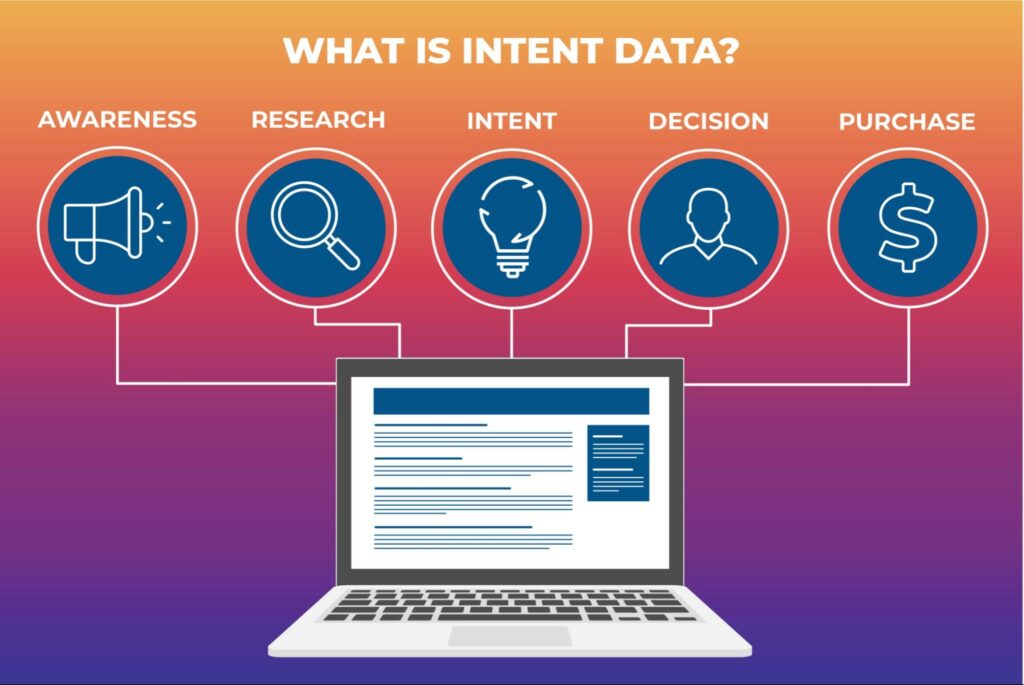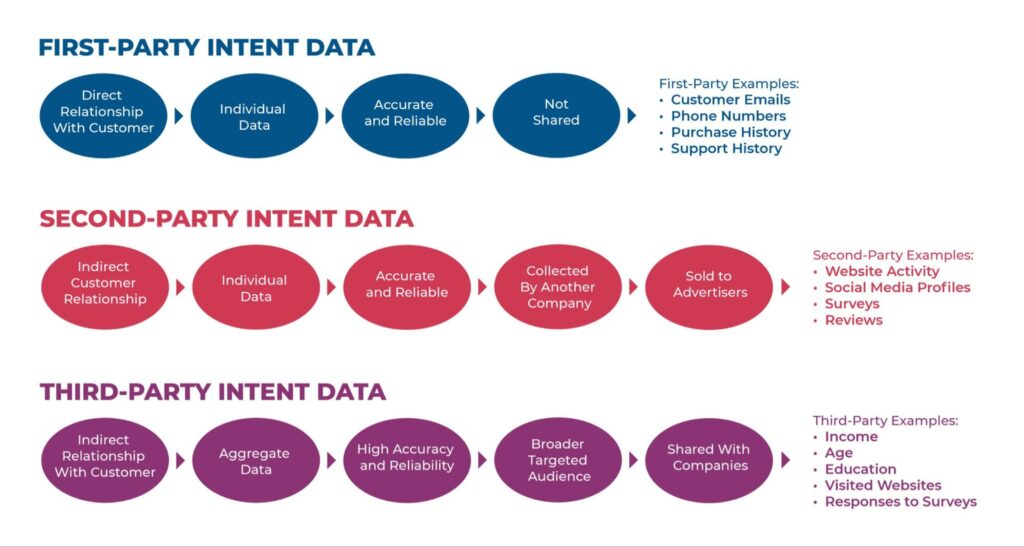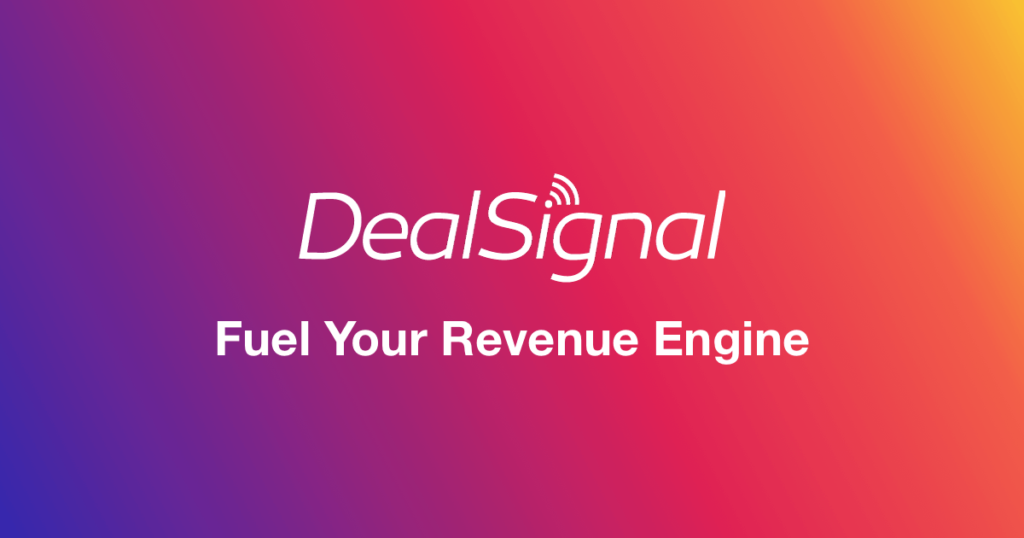What is Intent Data: The Best Way to Unplug Your Revenue Pipeline?
Understanding the intricacies of web tracking, including measurements, analysis, and reporting, can get confusing. Through web tracking, companies can collect, store, and share information about a buyer’s activity on their website, allowing them to personalize the content buyers see. With tools like Google Analytics, web tracking also enables you to use cookies to track specific users and IP addresses within your company’s website platform.
Web tracking data and intent data may seem similar at first glance, but they are different types of data that serve different purposes. Web tracking data is collected, stored, and analyzed about user activity on a single website. The information gained from what is intent data, on the other hand, is collected from a variety of sources across tens of thousands of websites.
Imagine targeting a buyer before they even start their buyer journey. With intent data, you can.
- What is Intent Data: The Best Way to Unplug Your Revenue Pipeline?
- What Is Intent Data?
- Web Tracking Data vs Intent Data
- The Value of Intent Data in 2024
- How to Operationalize Intent Data
- What are The Benefits of Intent Data?
- Identify buyers faster
- Personalize your outreach
- Prioritize your efforts effectively
- Engage accounts earlier on
- How to Find a Quality Vendor for Intent Data
- Change The Game With Intent Data
- Learn what is Intent Data & Marketing Strategies
What Is Intent Data?
But what is Intent Data? Intent Data is a dataset that proactively identifies potential buyers searching online for similar products and services that your company is selling. When buyers search for particular topics or keywords, those create intent signals based on their searches or page views across tens of thousands of websites across the internet. For businesses, this means understanding when buyers are actively researching products and services, bringing them closer to a decision that will lead to a sale or conversion.
For example, you probably engaged in an online search for ”What is intent data?” to find information on intent data which led you to this article. You may have even started this search with the intent to take a specific action that could potentially lead you to a final buying decision on a product or service.

Think about how your company would benefit from knowing when your prospects were researching a solution like yours shortly after starting their buyer journey.
Typically, buyers narrow down their options before making a final decision. If the buyer never reaches your website, you never even had a chance to connect with them. When used correctly, the information you can gain from what is intent data can provide buying signals across tens of thousands of websites that will help your team prioritize qualified accounts that are active in a buying cycle, positioning you to be the first in line to make your pitch.
Web Tracking Data vs Intent Data
Web tracking also referred to as website tracking, describes the process of gathering, storing, and analyzing data on user activities while they are on a website. The information collected can include the pages visited, how long the visit lasted, the location of the visitor, and any interactions or conversions that occurred on the website. Companies use web tracking to gain a better understanding of how users interact with their website, track website traffic, and make data-driven decisions to enhance the overall user experience.
You are probably more familiar with web tracking than you think. Using a proper web tracking tool like Google Analytics, you’ll collect various visitor insights like knowing when a user is on your site via desktop or mobile app. It also provides information, including the number of visitors, the pages they visit and the duration of their visits.
This data can assist businesses in determining which pages are the most popular and where users tend to drop off. Additionally, web tracking can be used to track campaigns, such as email or social media campaigns, to understand how users are interacting with the website as a result of the campaign. It can also be used to analyze website performance, including page load speeds, bounce rates, and other key metrics that can inform decisions about website optimization and user experience.
One of the main negative aspects of web tracking compared to what is intent data is that it is primarily focused on understanding how users interacted with a website in the past, while intent data is more forward-looking and focused on understanding a user’s intent and interests based on their online behavior.
This makes intent data more useful for B2B companies that are trying to identify and target potential customers early in the buying process. Intent data can provide insights into the specific topics, products, or services that users are interested in and the companies a user is researching. This can help B2B companies to understand the specific areas of interest for their potential customers and tailor their marketing and sales efforts accordingly.
With what is intent data, online users browse the internet and leave a trail of intent signals, including page clicks, scroll speed, amount of content consumed, time spent on the page, etc. The strength of these signals indicates the amount of interest a user has in your product or service. These signals make up intent data, creating an invaluable dataset that is ultimately a game-changer for boosting conversions and sales. It also provides information such as:
- Which companies have the intent to buy your product or service?
- How much is your prospect’s interest increasing?
- Where did your prospect’s interest originate?
- How much intent for your product or service has increased in the past week?
The Value of Intent Data in 2024
Determining the best course of action and the value of intent data is probably the most challenging part for sales and marketing teams. Intent data presents the opportunity to identify early buyer interest with intent signals. With intent data, you gain a competitive advantage by being able to build, filter, and prioritize targeted account lists, personalize outreach, and predict and weigh your lead scoring model. All this together can ultimately help you quickly build a larger revenue pipeline, increase conversion rates and acquire new customers.
First things first, your team should create a solid intent data strategy to help execute quality outreach campaigns. Sales and marketing teams can rely on intent data to implement effective go-to-market strategies, build ideal customer profiles (ICPs), personalize their outreach to specific buyer personas, and create more quality leads. Leveraging real-time visibility into what your prospects want amplifies your competitive edge. This allows you to proactively identify customer pain points, take advantage of up-selling opportunities, and stay updated on your competitor’s offerings.
Potential buyers have probably been trying to solve a specific pain point for weeks, maybe even months. By leveraging intent data, you have the chance to catch these prospects early before they skip over your website. Being the first to identify and solve their pain points puts you at the top of their list. Once you see prospects putting you first, you start to appreciate the value of targeting a buyer before they even start their buyer journey.
How to Operationalize Intent Data
When it comes down to it, understanding how to correctly operationalize and integrate what is intent data into your preferred choice of software can be confusing. Operationalizing intent data helps generate demand and quickly build a strong sales pipeline allowing you to make the most of your data to drive leads and revenue.
There are three types of intent data:

- First-party Intent Data: This type of intent data is collected by the business itself, through the use of analytics tools like Google Analytics, marketing automation platforms, or the company’s website. It allows businesses to track valuable insights of buyers’ online activity, such as their engagement with social media, email campaigns, and website interactions. This data can be used to understand how buyers interact with the company’s digital presence, and make data-driven decisions to improve the overall user experience.
- Second-party Intent Data: Information collected by another company, and then shared or sold to other businesses. For example, media publishers may sell data on their audience’s interests and behaviors to advertisers, which is considered second-party intent data. This data can be useful for businesses looking to understand the interests and behaviors of a specific audience, and can be used to inform targeted marketing campaigns.
- Third-party Intent Data: Data that is collected by vendors who offer data or intent-driven solutions to businesses. These vendors provide a more holistic view of a prospect’s buying activity by collecting data from multiple sources. Third-party intent data offers an extensive scale, which can help marketers access more new prospects and seamlessly transition them into their pipeline. This data can be particularly valuable for businesses looking to identify new potential customers and target their marketing efforts more effectively.
Check out this guide, Intent Data: How to Use it to Generate Quality Sales and Marketing Leads, on operationalizing intent data for a more in-depth overview.
What are The Benefits of Intent Data?
Identify buyers faster
This data type equips you with the insights to pinpoint when a lead is primed for sales engagement. Identifying the optimal moment to reach out can significantly impact your close rate. Yet, as we demonstrated earlier, merely having this information doesn’t guarantee a swift response. Later on this page, we’ll guide you on leveraging it effectively to ensure your team responds promptly.
Personalize your outreach
Harness the power of intent data to gain insights into your lead’s specific interests and preferences. If they were exploring a particular product page on your site, it’s a clear indication of their interest in that specific offering. On the other hand, if they were perusing your competitor’s page on a software review site, they might be actively considering alternatives. The depth of understanding provided by intent data empowers you to personalize your outreach effectively. By responding in a way that resonates with their intentions, you not only increase the likelihood of your message being seen but also enhance the chances of achieving your desired outcome—whether it’s retaining a client or successfully introducing them to another product.
Prioritize your efforts effectively
Leveraging buyer intent data empowers you to make well-informed decisions about the order in which you respond to leads. For instance, if one lead is actively exploring multiple pages of your competitors on a software review site, while another lead is engaging with news articles within your industry, prioritizing a response to the former is prudent. Their browsing behavior indicates a higher likelihood of making a purchasing decision in the near term.
Engage accounts earlier on
By the time a prospect fills out your demo request form, it’s likely they’ve conducted extensive research on various vendors in the market and formed their own conclusions. While your sales team can influence opinions during the demo call and subsequent meetings, shaping their views becomes more challenging at this stage.
To exert a more impactful influence, leverage intent data to prompt your reps to reach out earlier in the process. For instance, when a prospect initiates research on topics related to your platform, the designated sales representative can receive timely alerts. This allows them to proactively engage contacts at that account with a targeted message—accompanied by pertinent content from your site—tailored to capture their interest.
How to Find a Quality Vendor for Intent Data
Intent data monitoring is a powerful tool that can provide valuable insights into the behavior and interests of your customers and prospects. It can help you understand what content they are consuming, what actions they are taking, and what topics they are engaging with, which can in turn inform your marketing and sales strategies. However, selecting the right intent data provider can be a difficult task, as there are many options available and it can be challenging to understand the differences between them.
When evaluating potential intent data providers, it is important to consider a variety of factors, including the quality and accuracy of the data, the ease of use and integration of the provider’s platform, and the level of customer support and service provided. Here are a few specific questions you can ask to help guide your decision-making process:
- How broad is the coverage?
- How accurate is the data?
- How often can you pull new data?
- Can the provider deliver a thorough breakdown of how the scores are calculated?
- Where does the data map to accounts, leads, or both?
- Can this provider securely integrate with your existing CRM?
- Can you customize the topics and keywords you track?
- What is the cost and are there any guarantees?
- Is there efficient customer support?
If you need more clarification, this definitive guide for choosing the right B2B data provider will help you understand the differences between various vendors and which performance factors really matter to help increase your bottom line.

Change The Game With Intent Data
It’s essential to prioritize vendors not only with large-scale intent data coverage across tens of thousands of websites but also to measure those vendors on the precision and accuracy of their results. It is also vital to learn how to choose the right data provider to help your sales & marketing teams effectively convert intent data into quality leads and customers.
Intent data enables you to broaden your reach to prospective customers who have never visited your website, target those with the highest intent to buy, and precisely filter the contacts who are the best prospects. When selecting the right third-party intent data provider, do your research and understand where they collect their data and how they help you operationalize it.
When it comes down to answering the question ”What is Intent Data”, Deal Signal is a reliable partner that makes understanding the intricacies of user intent easy. DealSignal’s intent data, specifically, can help you uncover hidden buying teams, prioritize in-market accounts, and personalize your ABM to drive more conversions faster. By tracking millions of users across thousands of B2B websites, DealSignal’s third-party intent data can help you see if these users are showing interest or buying signals in product or service offerings like yours, giving you a clearer understanding of what is intent data and how it can help your business.

DealSignal aggregates what all these users are searching and consuming by topic. If these users don’t visit your website, you will never know that those potential customers have an interest in what you offer. With the largest network of what is intent data to surface unknown buyers and a 97% percent accuracy rate, DealSignal is ready to help you improve your go-to-market, lead generation and revenue pipeline development.
With DealSignal, you can prioritize your marketing and sales campaigns to catch prospects early in their research and decision-making process. Schedule a free demo to see firsthand how the DealSignal platform can fuel your revenue engine with higher-quality data.
Learn what is Intent Data & Marketing Strategies
- Intent Data : How to Use it to Generate Quality Sales and Marketing Leads
- How Intent-based ABM Helps Optimize Your Go-To-Market Strategy
- Not All B2B Contact Data Is Created Equal: How Data Accuracy Impacts Sales and Marketing Performance and Costs
- B2B Demand Generation: 7 Ultimate Success Factors
- How B2B Data Quality Impacts Email Deliverability




